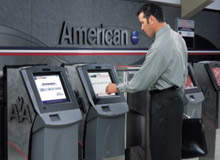
Over the last few years, airlines operating in busy airports around the world have been educating clientele on the benefits and use of self-service kiosks and online check-in services. And while the queue remains, either for luggage check-in or for the use of kiosks themselves, the pure cost savings have encouraged the number of kiosks in use to grow.
In Q3 of 2006, according to a survey conducted by analyst firm Forrester, out of 2,869 airline passengers travelling for leisure, 86% had used a self-service check-in kiosk.
For the airlines, such technology has brought about massive cost savings. Forrester Research vice president Henry Harteveldt says previously, it cost the airline $3.02 per passenger for conventional check-in services. With kiosks, this cost has been reduced to 14¢.
But at the use of kiosks has started to grow, and become an everyday part of airline travel, airports have started to ask where they can cash in.
New common-use self-service (CUSS) kiosks are being used by some airports to help ease security risks when processing customers travelling between different terminals for connecting flights or passengers travelling on numerous airlines.
“Using CUSS breaches the gap between communicating with individual airlines and the port itself,” Harteveldt says.
How well do you really know your competitors?
Access the most comprehensive Company Profiles on the market, powered by GlobalData. Save hours of research. Gain competitive edge.

Thank you!
Your download email will arrive shortly
Not ready to buy yet? Download a free sample
We are confident about the unique quality of our Company Profiles. However, we want you to make the most beneficial decision for your business, so we offer a free sample that you can download by submitting the below form
By GlobalDataARE YOU BEING SERVED?
Self-service check-in first emerged about 20 years ago, but was rudimentary and only used by a few airlines on a few routes. The current versions of self-service check-in services are a world away from these first models, having been developed in 2000.
The technology itself was really brought into line after the terrorist attack on 11 September. New check-in service requirements for security meant that people were moving through the check-in lines much slower. Self-service check-in seemed to be a way to help improve customer service while driving down staff costs.
Security with self-service check-in though, has always been a bone of contention. Online check-in services before the 11 September attack had already been shut down internationally as part of a move by the travel industry because of security parameters. But the check-in services got smarter, and were eventually able to identify security threats before a passenger boarded the plane.
Some problems still exist with security. According to Harteveldt, airlines like United Airlines, which allows passengers to use any card with their names on it to search for a reservation, can pose a problem where more than one passenger has the same name. In this case a passenger can easily gain access to another traveller’s personal information, and even worse, their boarding pass. Security risks were not the only concerns late 2001. Network reliability is also paramount to the proper running of such as solution.
According to Harteveldt, some airlines have already experienced problems where an airlines servers or data links have gone down, taking the kiosks with them. “Given the staff cutbacks by most airlines, that practically guarantees a delayed operation, not to mention grumpy passengers. Looking at the airline industry, security risks are at a minimum.”
SERVICING THE FUTURE
The major players in the kiosk field at present are IBM, Kinetics, Oki, SITA, NCR and Sabre Holdings Corporation. These companies are increasingly working to iron out issues with security and with networking for their clientele, which also includes the airports investing in self-service technologies.
Harteveldte says these companies are already innovating with the ‘mobile generation’ in mind. While passengers today may not be overly savvy with using mobile technologies for activities beyond text messages, calls and surfing the web, wearable mobile technologies, it is predicted, will one day become common place.
When this happens, these companies will have the technology in place to make the use of airport kiosks a mobile activity, further reducing the management cost to the operator and increasing the service level offered to customers.
“How users take up this technology, and where problems will lie and how they’re handled will determine largely the speed of this technology to market,” Harteveldte says.
But there are foreseeable risks such as loss or theft of mobile devices, and authentication of the person travelling.
“The issue is that an employee at the entrance to the security screening area would need to ensure that the person who holds the device is indeed its owner and has a legitimate boarding document. This has been resolved in Asia and Europe for domestic flights, mostly, but has not been resolved in the US.” This would the same at any airport-issued kiosk.



